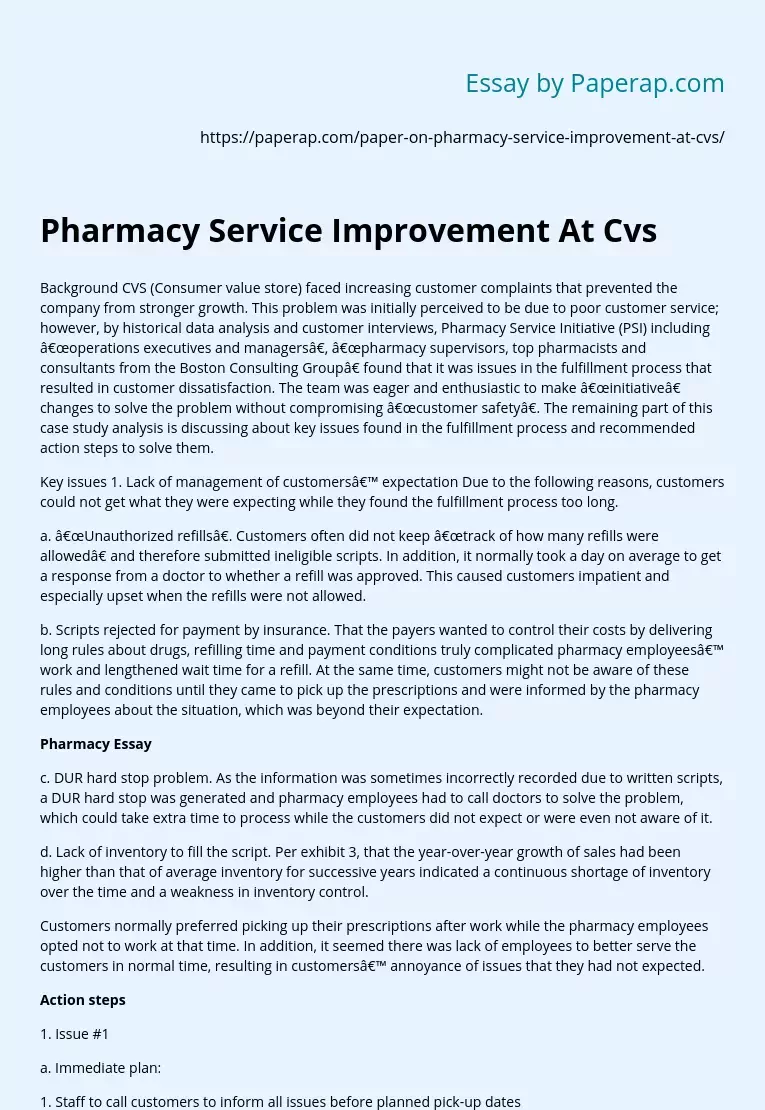Pharmacy Service Improvement At Cvs
In the following example, an essay talks about improving pharmacy service at Cvs. Read the introduction, body and conclusion of the essay, scroll down.
Background CVS (Consumer value store) faced increasing customer complaints that prevented the company from stronger growth. This problem was initially perceived to be due to poor customer service; however, by historical data analysis and customer interviews, Pharmacy Service Initiative (PSI) including “operations executives and managers”, “pharmacy supervisors, top pharmacists and consultants from the Boston Consulting Group” found that it was issues in the fulfillment process that resulted in customer dissatisfaction.
The team was eager and enthusiastic to make “initiative” changes to solve the problem without compromising “customer safety”. The remaining part of this case study analysis is discussing about key issues found in the fulfillment process and recommended action steps to solve them.
Key issues 1. Lack of management of customers’ expectation Due to the following reasons, customers could not get what they were expecting while they found the fulfillment process too long.
a. “Unauthorized refills”. Customers often did not keep “track of how many refills were allowed” and therefore submitted ineligible scripts. In addition, it normally took a day on average to get a response from a doctor to whether a refill was approved. This caused customers impatient and especially upset when the refills were not allowed.
b. Scripts rejected for payment by insurance. That the payers wanted to control their costs by delivering long rules about drugs, refilling time and payment conditions truly complicated pharmacy employees’ work and lengthened wait time for a refill.
At the same time, customers might not be aware of these rules and conditions until they came to pick up the prescriptions and were informed by the pharmacy employees about the situation, which was beyond their expectation.
Pharmacy
c. DUR hard stop problem. As the information was sometimes incorrectly recorded due to written scripts, a DUR hard stop was generated and pharmacy employees had to call doctors to solve the problem, which could take extra time to process while the customers did not expect or were even not aware of it.
d. Lack of inventory to fill the script. Per exhibit 3, that the year-over-year growth of sales had been higher than that of average inventory for successive years indicated a continuous shortage of inventory over the time and a weakness in inventory control.
Customers normally preferred picking up their prescriptions after work while the pharmacy employees opted not to work at that time. In addition, it seemed there was lack of employees to better serve the customers in normal time, resulting in customers’ annoyance of issues that they had not expected.
Action steps
1. Issue #1
1. Staff to call customers to inform all issues before planned pick-up dates
Pro: To manage customers’ expectation. They would be aware of the issues before they came to pick up the prescription.
Cons:
- Increase in the number of staff involved in the process, worsening the manpower shortage crisis.
- Increase in costs accordingly.
2. Inventory control system to be put in place to ensure inventories would be always sufficient to fill the scripts.
Pro:
- Reduce the processing time and customers’ dissatisfaction;
- Effective use and order of inventory; Cost savings because the company could determine the best time in terms of prices to purchase inventory.
Cons: not applicable.
b. Long-term plan: build up an online customer database with sufficient required information and grant access to customers so that either customers or their doctors could fill in the scripts by themselves.
Pros:
- Customers could plan and manage their time to fill in and review the scripts, their prescriptions and refills, rules about drugs, refilling time and payment conditions set by the payers, etc. In addition, this practice would help avoid misinterpretation of written scripts.
- CVS could release their employees from a lot of workload and resolve the manpower crisis. CVS could also save costs accordingly.
Con:
- Investment capital requirement may be high, significantly affecting cash position and reducing net income of the company during the depreciation period.
2. Issue #2
a. Immediate plan: Recruit part-time employees to work in after-work time
Pro: reduce the wait time and respond more quickly to customers, increasing customers’ satisfaction.
Cons:
- Increase in the number of staff involved in the process, worsening the manpower shortage crisis.
- Increase in costs accordingly.
b. Long-term plan: described in the long-term plan for issue #1 with the same pros and cons.
Conclusion
Though there were pros and cons for the recommended solutions, I personally believe pros would outweigh cons as increase in customer satisfaction would surely contribute to the increase in the company’s net operating revenues and the solutions were especially looking at long-term growth.
Pharmacy Service Improvement At Cvs. (2019, Dec 05). Retrieved from https://paperap.com/paper-on-pharmacy-service-improvement-at-cvs/

